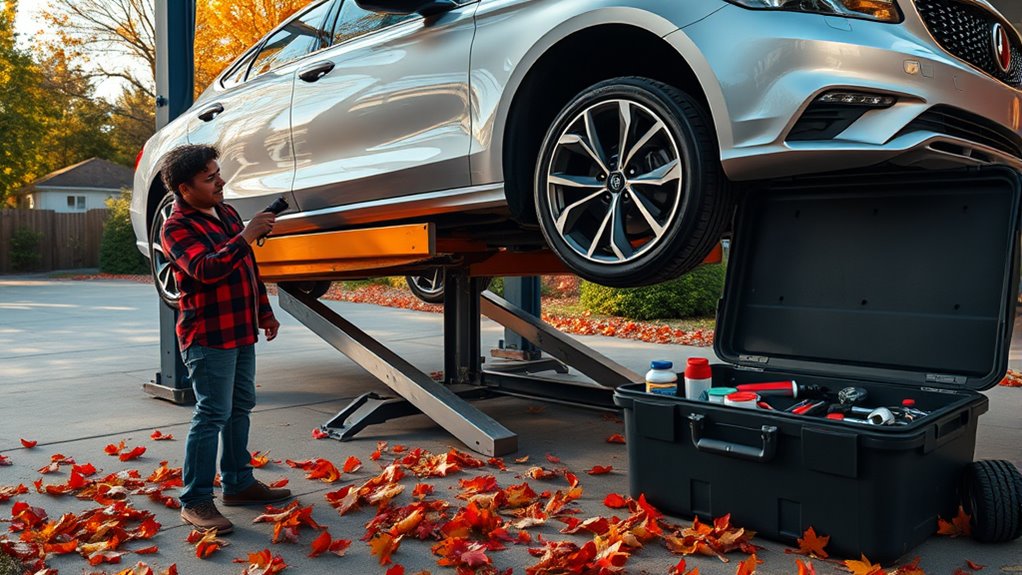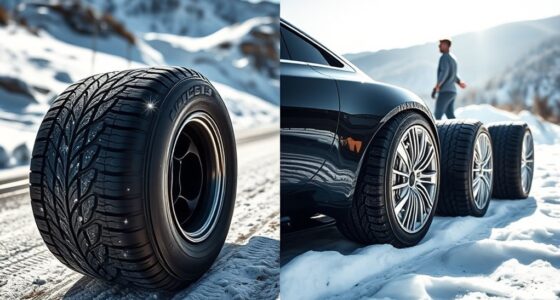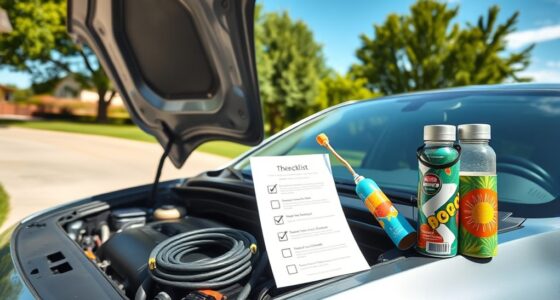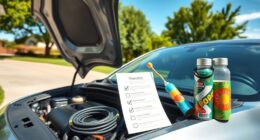To get ready for cooler weather, start by checking your tire pressure and inflating them to the recommended PSI to guarantee safety and better fuel economy. Inspect your battery for corrosion and test its voltage to prevent unexpected breakdowns. Verify that all lights and wipers are working properly, and switch to winter windshield washer fluid. Considering winter tires can also boost traction. Continue exploring for more tips to keep your vehicle winter-ready and safe all season long.
Key Takeaways
- Check and inflate tires to the recommended PSI to ensure safety and fuel efficiency during cooler months.
- Inspect and clean battery terminals; replace the battery if it’s over 3-5 years old or shows low voltage.
- Test all lights and switch to winter windshield washer fluid for optimal visibility in shorter, foggy days.
- Examine windshield wipers for wear and consider switching to winter tires if heavy snowfall is expected.
- Perform routine vehicle checks now to prevent breakdowns and ensure reliable performance throughout fall and winter.
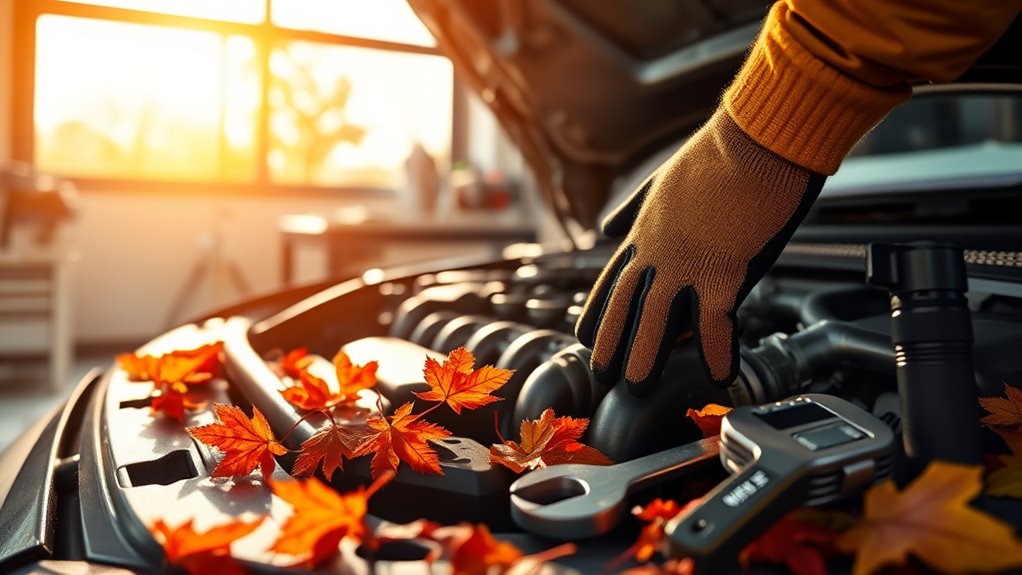
As the leaves change color and temperatures begin to drop, it is essential to give your car a thorough fall maintenance check. Cooler weather can impact your vehicle’s performance, so taking a few preventive steps now can save you trouble later. Start with a tire inspection. Cold air causes tire pressure to drop, which can reduce fuel efficiency and compromise safety. Use a reliable pressure gauge to check each tire, including the spare. Inflate them to the manufacturer’s recommended PSI, usually found on the driver’s side door frame. Properly inflated tires not only improve traction on wet or icy roads but also extend their lifespan. While inspecting, look for uneven wear, cracks, or bulges that could signal a need for replacement. Worn or damaged tires can be dangerous during winter conditions, so replace them if necessary.
Next, turn your attention to the battery check. As temperatures fall, your car’s battery has to work harder to start the engine. A weak or aging battery might struggle in colder weather, leaving you stranded. Inspect the battery terminals for corrosion, which appears as a white or bluish powder. Clean them with a wire brush to guarantee a good connection. Check the battery’s overall condition by testing its voltage with a multimeter or having a professional do it for you. If the voltage reads below 12.4 volts, it’s time to think about a replacement. Also, keep an eye on the battery’s age—most batteries last about three to five years. If yours is near or past that mark, it’s wise to replace it before winter strikes.
Additionally, proper maintenance of headlights and taillights ensures maximum visibility during shorter daylight hours and foggy conditions. While you’re at it, don’t forget to examine other critical components. Check your windshield wipers and replace any that leave streaks or don’t clear the glass effectively. Stock up on winter windshield washer fluid, which resists freezing. Inspect your headlights, taillights, and brake lights to guarantee they’re functioning properly; visibility is key as days get shorter. Consider switching to winter tires if you live in an area with heavy snowfall, as they provide better traction.
Getting your car ready for fall isn’t complicated, but it makes a huge difference in safety and reliability. By performing a tire inspection and battery check now, you prevent inconvenient breakdowns and guarantee your vehicle performs well in the cooler months ahead. A little maintenance today keeps you safe, saves money, and gives you peace of mind during your fall drives.
Frequently Asked Questions
How Often Should I Check My Tire Pressure in Fall?
You should check your tire pressure regularly, ideally once a month, to guarantee safe driving. Tire pressure monitoring is vital because it helps you catch leaks or pressure drops early. During a seasonal tire inspection, pay special attention to your tires, especially in fall when temperatures fluctuate. Maintaining proper tire pressure improves fuel efficiency and reduces tire wear, so make it a habit to monitor your tires frequently, especially as weather changes.
Are Winter Tires Necessary in Mild Climates?
Like the changing seasons remind us of nature’s rhythm, your driving needs shift too. In a mild climate, winter tires aren’t always necessary; they’re like an extra layer of armor only needed when the seasonal change brings real cold and snow. If your tires lack durability against cold, investing in winter tires can improve safety and performance, ensuring you’re prepared for the occasional icy patch without overdoing it in milder weather.
When Should I Replace My Windshield Wipers?
You should replace your windshield wipers when you notice streaks, squeaking, or reduced visibility during rain. Timely windshield wiper replacement guarantees ideal visibility, especially in bad weather. Don’t wait until they’re completely worn out, as damaged blades can impair your ability to see clearly and compromise safety. Regularly check and replace your wipers to maintain clear sightlines and improve driving safety in all conditions.
How Can I Prevent Battery Failure in Cold Weather?
Think of your battery as the heart of your car, quietly working to keep everything alive. To prevent battery failure in cold weather, you need to give it some extra care. Regular battery maintenance, like checking terminals for corrosion and ensuring it’s properly charged, is key. Cold weather prep involves testing your battery’s health and replacing it if it’s weak. This way, you keep your car running smoothly, no matter how chilly it gets.
What’S the Best Way to Store My Car for Winter?
When storing your car for winter, you want to protect it from the cold. Start by cleaning it thoroughly and topping off winterizing fluids, especially antifreeze levels, to prevent freezing. Consider using a car cover to shield it from snow and ice, and disconnect the battery to avoid drainage. Fill the tank to prevent moisture buildup, and store it in a garage if possible for added protection.
Conclusion
As the leaves change and temperatures drop, taking care of your car now helps guarantee smooth sailing ahead. By giving your vehicle a little extra attention, you’re not just preparing for cooler days—you’re setting the stage for safe journeys and peace of mind. Remember, a well-maintained car is like a trusted companion, quietly supporting your adventures. Embrace these small steps now, and you’ll find comfort in knowing you’re ready for whatever the road brings.
